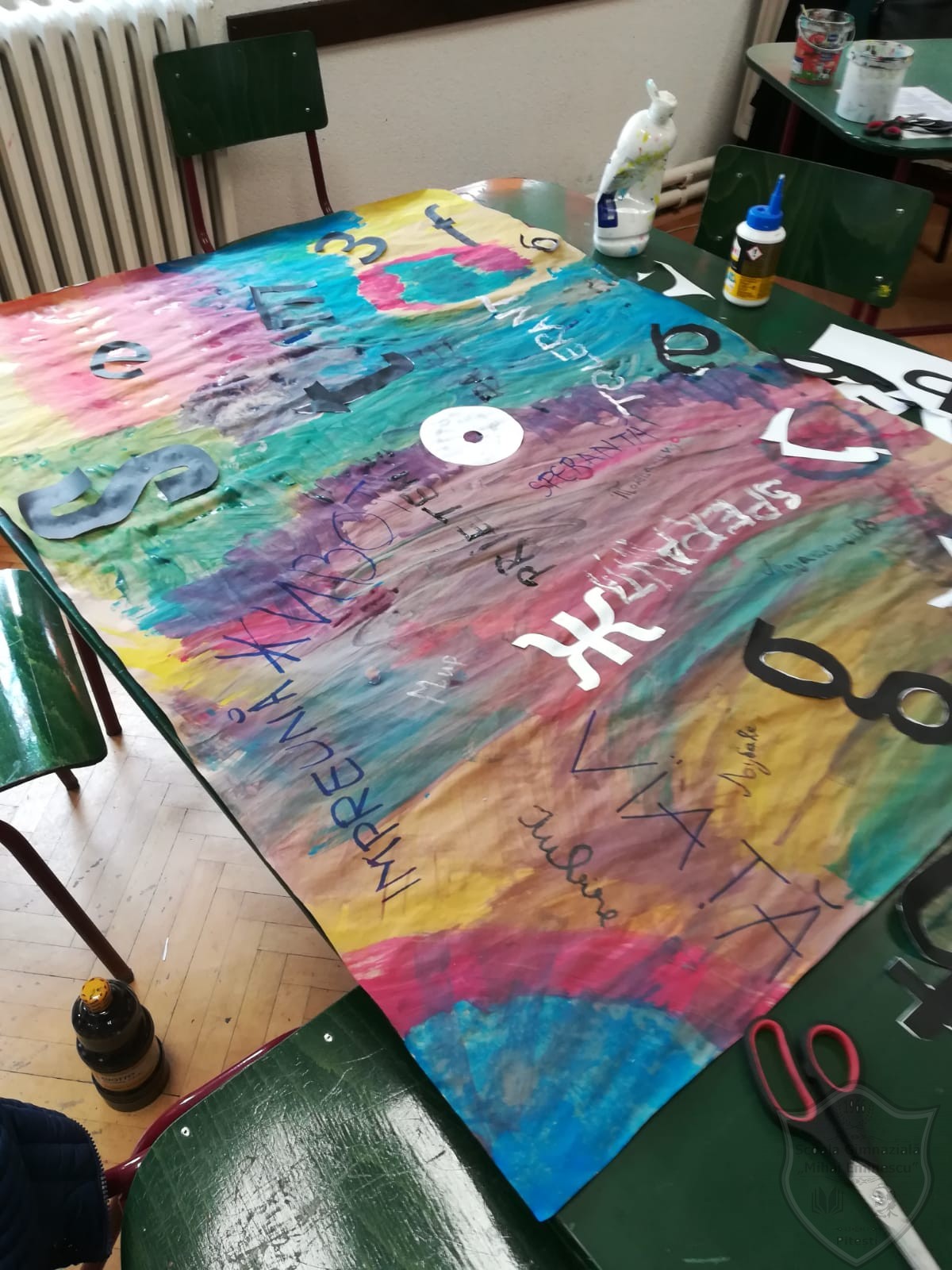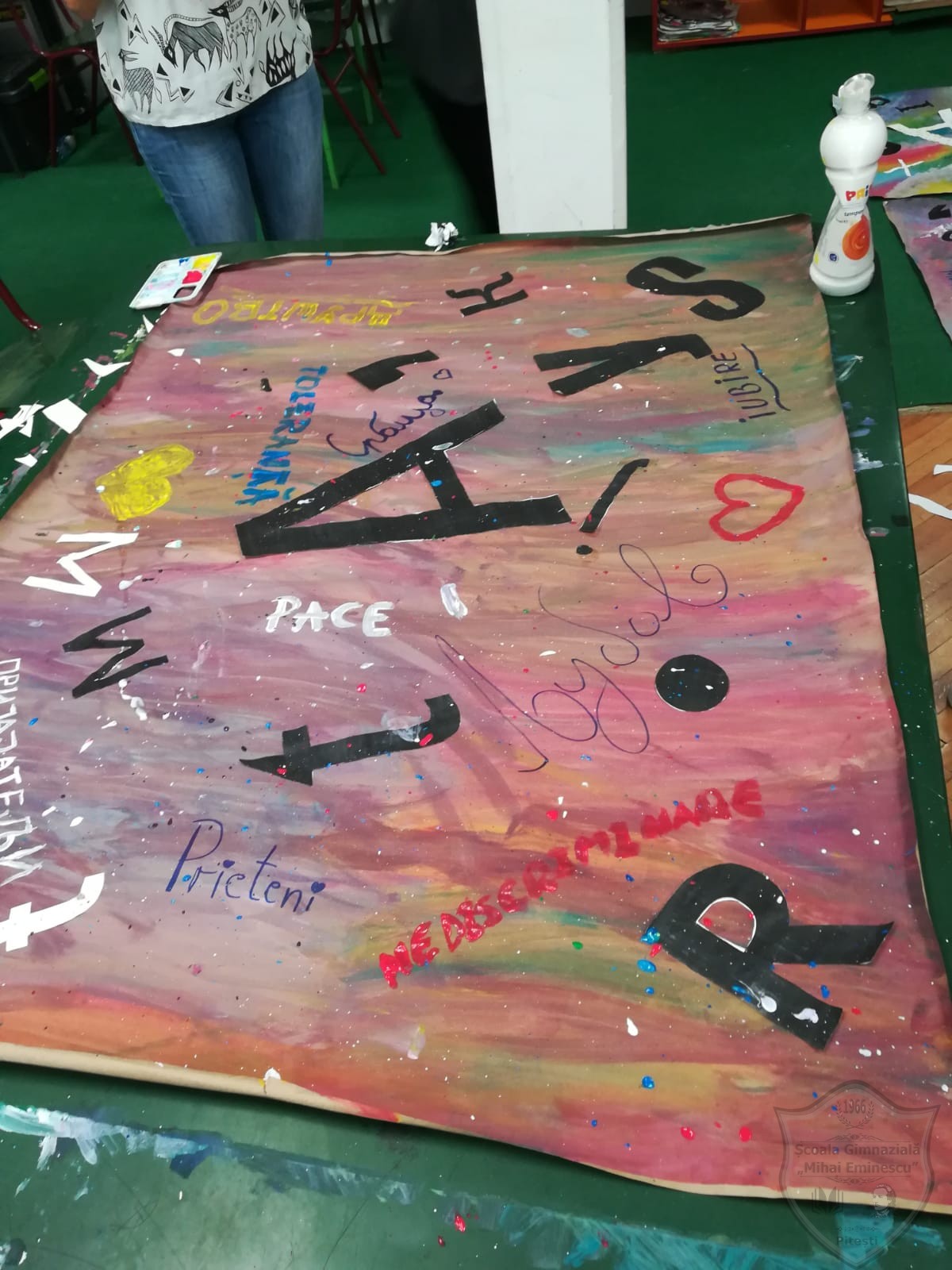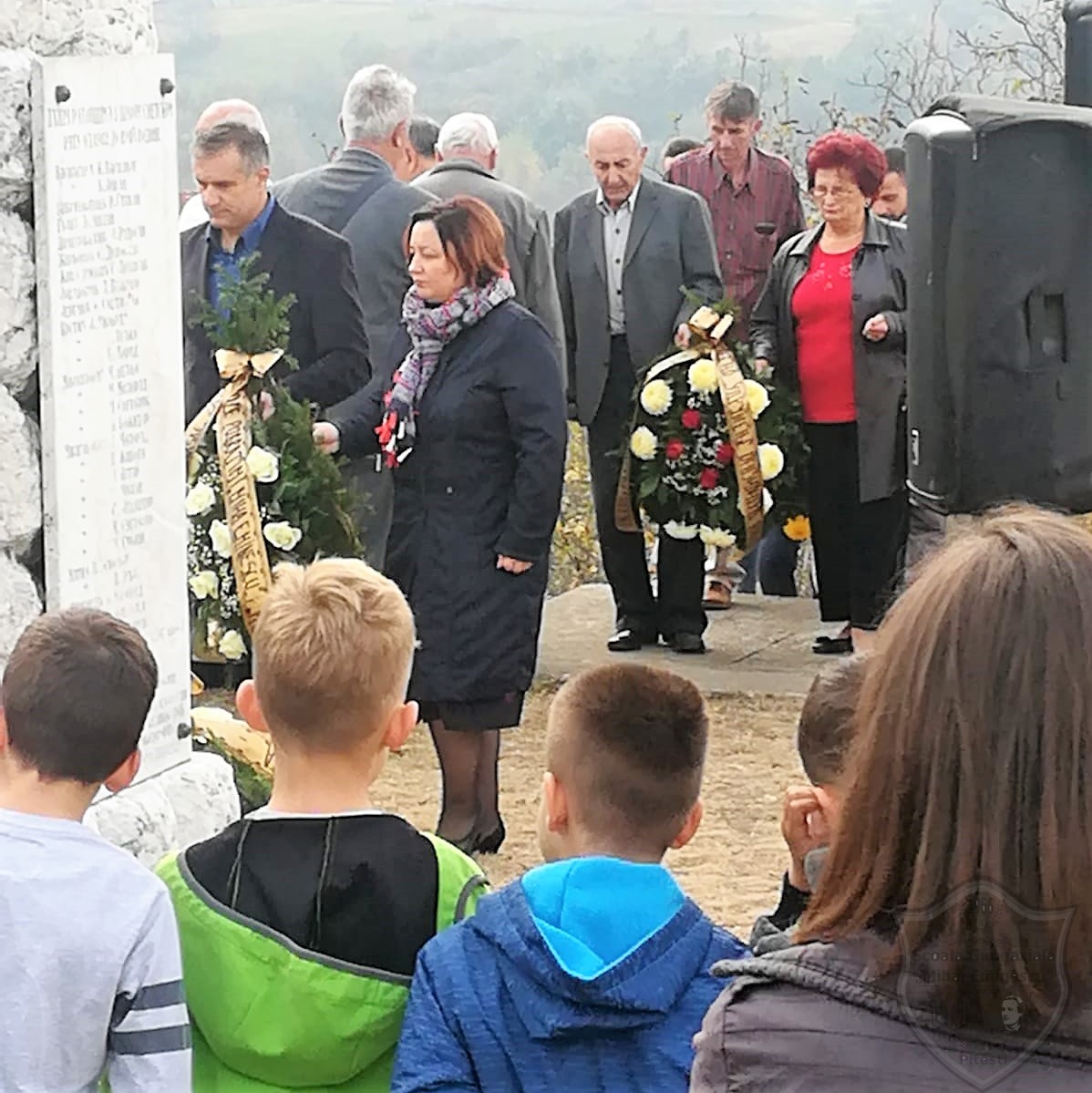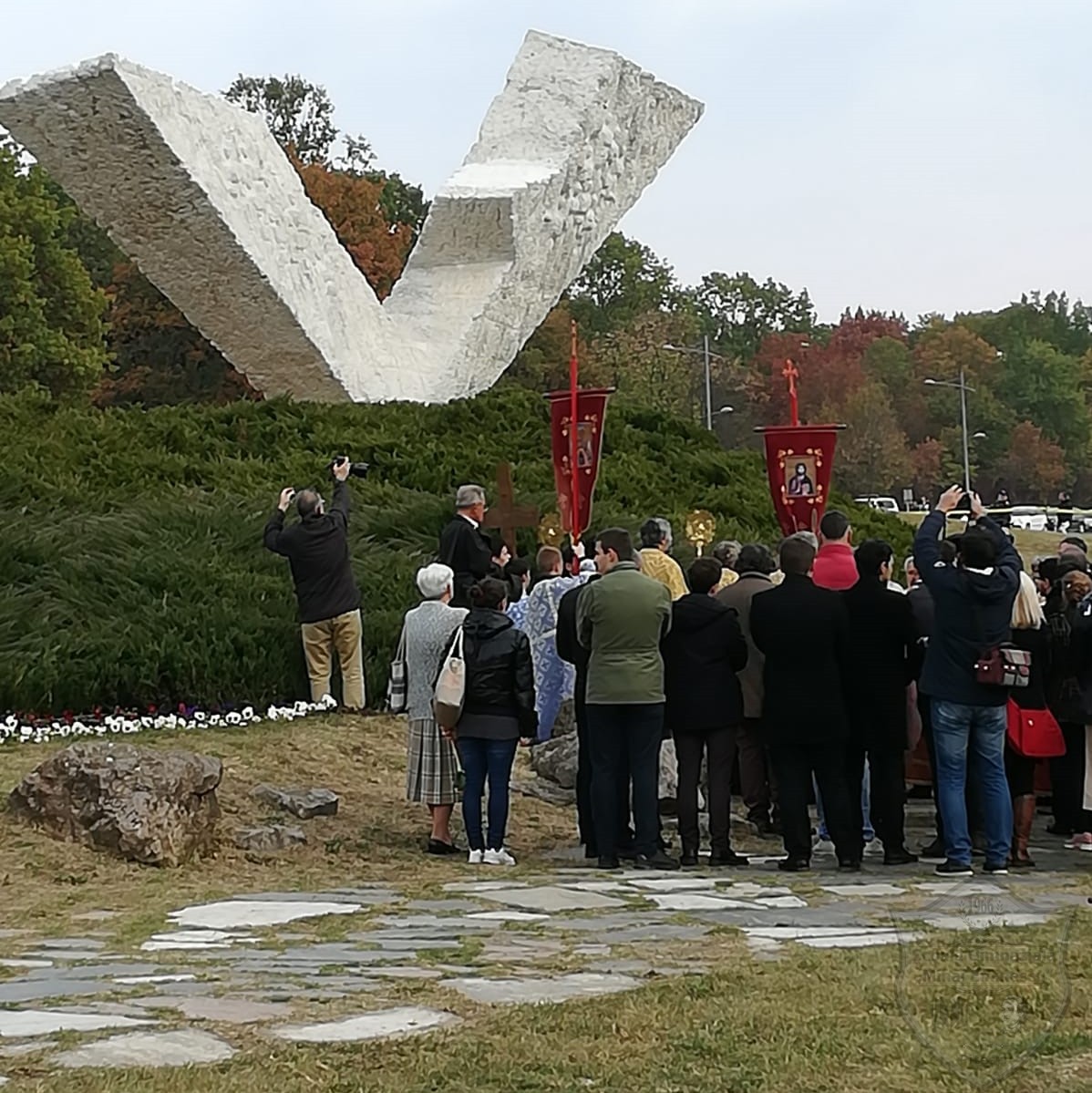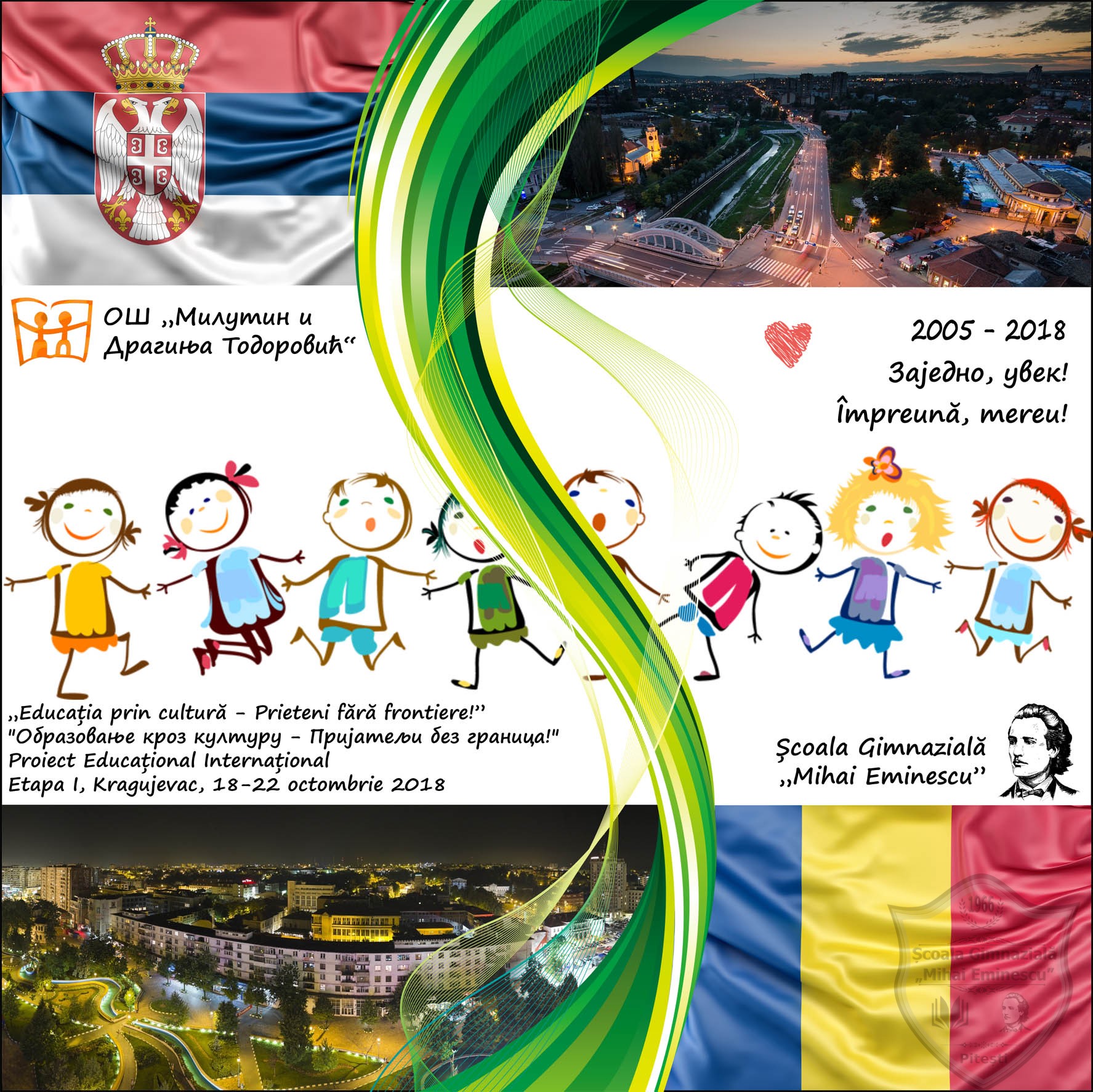
În perioada 18-22 octombrie 2018 s-a desfășurat prima etapă a proiectului internațional „Educația prin cultură- Prieteni fără frontiere”, aflat la a XIII-a ediție, pe care Școala Gimnazială „Mihai Eminescu” Pitești îl realizează anual cu Şcoala Milutin I Draginja Todorovic -Serbia, în spiritul cunoașterii directe a civilizației și culturii vecinilor noștri sârbi din orașul Kragujevac. De altfel, orașul Pitești și orașul Kragujevac sunt înfrățite încă din 1971, în anul 2000 reînnoindu-se această relație de bună colaborare care a permis schimburi culturale, burse pentru elevi și studenți, vizite ale celor două municipalități.

Proiectul educațional pe care cele două școli îl desfășoară de treisprezece ani s-a dovedit a fi un succes, prin obiectivele stabilite, precum cunoașterea și autocunoașterea prin intermediul unei experiențe directe: în prima etapă a proiectului, elevii piteșteni devin parte a unei familii sârbe timp de cinci zile, pentru ca apoi, în a doua etapă a proiectului, copilul de la Şcoala Milutin I Draginja Todorovic să fie găzduit de familia din România. Astfel, legăturile de prietenie devin puternice, adeseori copiii sârbi și români păstrând legături strânse, care devin punte de comunicare reală și directă între două popoare.

În dimineața zilei de 18 octombrie, o delegație a Școlii Gimnaziale „Mihai Eminescu” Pitești, formată din cinci cadre didactice: dir. adj. Iris Tănăsescu, prof. Nadia Pantazică, prof. Zamfir Florentina, prof. Mariana Băbuși, prof. Valentina Coman și 10 elevi ai școlii, a pornit către orașul Kragujevac, Serbia, aproape toți urmând să intre pentru prima dată în contact cu o lume nouă, slavă, situată într-un spațiu balcanic cu un destin frământat, care ne-a impresionat prin ospitalitate, generozitate și bucurie de viață, dar și prin respectul pentru adevărul istoric, pentru pierderile suferite în Al Doilea Război Mondial.

Ziua de 18 octombrie a prilejuit cunoașterea Serbiei în drumul spre Kragujevac. Într-o toamnă blândă și surâzătoare, grupul de elevi și profesori au urmat cursul Dunării de-a lungul malului sârbesc, privind cu nostalgie spre malul românesc și așteptând cu emoție întâlnirea cu prietenii sârbi.

În dimineața zilei de 19 octombrie, delegația de profesori români a participat la o ceremonie de comemorare a victimelor din Al Doilea Război Mondial, care a impresionat prin sobrietate și simplitatea sinceră. În continuarea zilei, elevii și profesorii români au fost oaspeții Şcolii Milutin I Draginja Todorovic, în cadrul unui program care a promovat educația interculturală.
Elevii au participat la un atelier de creație „Fine Art”, în care au lucrat în echipe sârbo-române pentru a crea postere cu ocazia sarbătorii a 200 de ani de la apariția primului dicționar sârbesc, publicat de marele cărturar Vuk Stefanović Karadžić, și au participat la o serbare organizată de școala gazdă în cinstea prietenilor români: cântece și jocuri populare sârbești, dar, ca o mare supriză care a emoționat delegația românilor, un cântec românesc.
Versurile cântate cu claritate și drag de copiii sârbi încă ne răsună în minte: „Rău ma dor ochii, mă dor/ de lumina stelelor…”. Delegației române i-a fost prezentată școala sârbească, cu caracteristicile ei: organizarea cursurilor, sistem de notare, planuri și proiecte.
Vizitând școala, profesorii au regăsit în expoziție, pe „Strada Pitești”, toate lucrările oferite ca amintire de Școala Gimnazială „Mihai Eminescu” Pitești de-a lungul celor treisprezece ani ai acestui longeviv proiect de educație interculturală dintre cele două școli.
Ziua de sâmbătă a fost o zi de cunoaștere a orașului, elevii români petrecând momente plăcute în familiile sârbe care le-au prilejuit experiențe care mai de care mai interesante: vizite la muzee, monumente, parcuri de joacă și Plaza Kragujevac. Directorul școlii, Dragan Pavlovic a condus delegația de profesori români în vizită la muzeul de istorie Svilajnac, la peștera Resava, la mânâstirea Manasija.
Ziua de 21 octombrie reprezintă pentru orașul Kragujevac şi pentru întreaga Serbie o zi de reculegere și comemorare. Chiar dacă delegația română știa ca va participa la comemorarea victimelor masacrului de la Sumarice, din octombrie 1941, când soldații naziști au omorât peste 5000 de civili, printre care și elevi ai școlii normale, momentele, ceremonia și atmosfera generală au fost impresionante. Pe câmpul de la Sumarice, din loc în loc sunt presărate monumente ridicate de orașe din Europa care deplâng alături de sârbi victimele războiului. Delegația de români a fost impresionată de monumentul ridicat de Primăria orașului Pitești, care reprezintă cinci aripi unite, simbol al aripilor frânte de război ale unei întregi clase a cincea în acea zi nefastă de 21 octombrie 1941.
Cele două școli au depus prin reprezentanții lor o coroană de flori la monumentul central de la Sumarice și au participat la un spectacol organizat de orașul Kragujevac: trei supraviețuitori ai masacrului își exprimă sentimentele față de ziua aceea și ce a urmat apoi pentru fiecare. După manifestare, românii au vizitat muzeul închinat victimelor Celui De-Al Doilea Război Mondial și au recunoscut într-o fotografie pe cei trei supraviețuitori jucați de actori pe scenă. Vizita la muzeu a fost, de altfel, plină de emoții: fotografii, bilete scrise de cei care așteptau să fie executați, profesori sârbi care-și recunoșteau membri ai familiei în fotografii, lucrări de artă care exprimă plânsul unui popor și, mai ales, o lucrare care este creată chiar cu puștile cu care au fost împușcați locuitorii orașului în 1941.
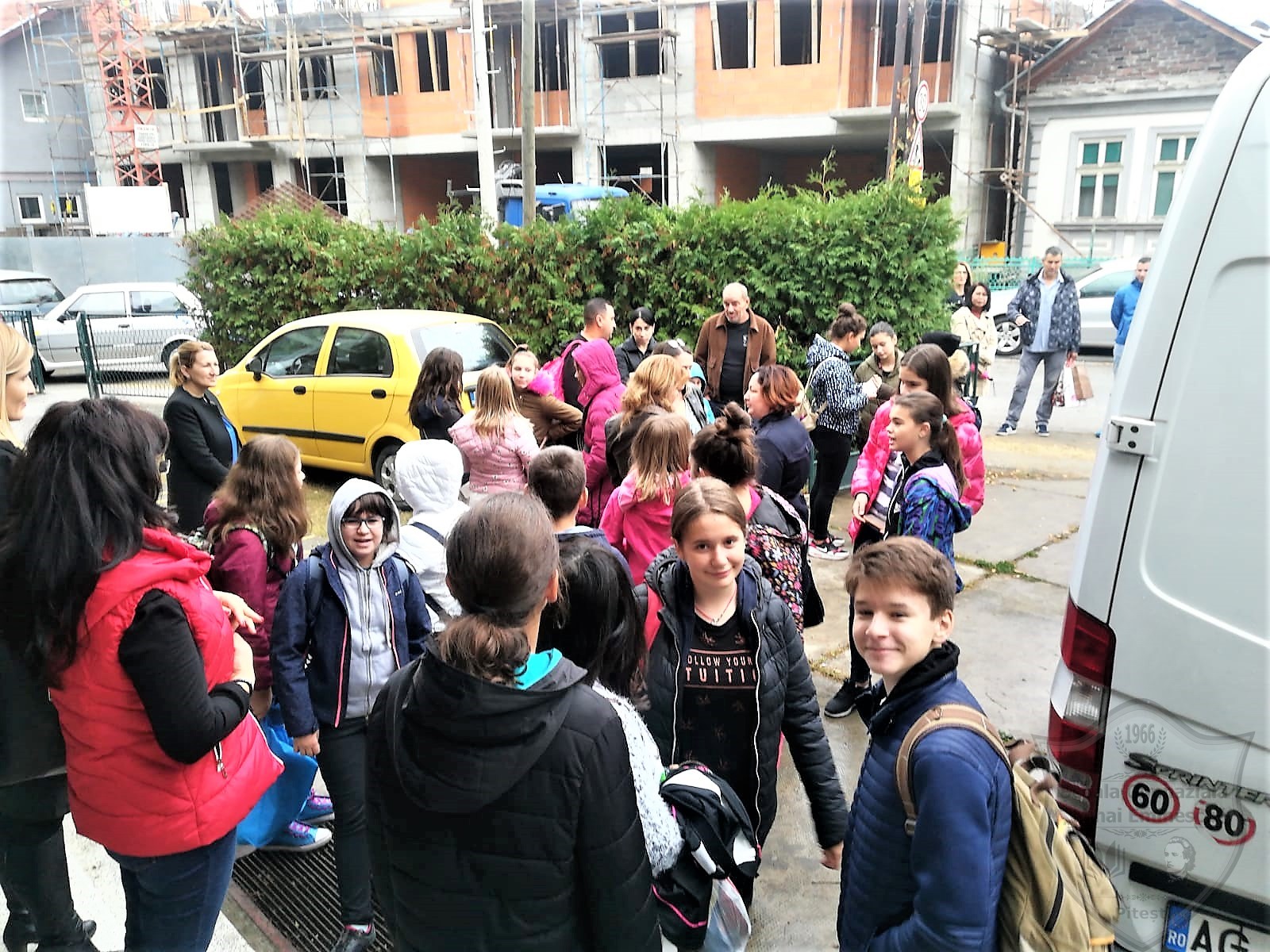
Vizita în orașul Kragujevac a fost, a fost, așa cum anunța încă din prima zi directorul Școlii Milutin I Draginja Todorovic, Dragan Pavlovic, o vizită care a celebrat viața, prietenia, respectul pentru trecut. Proiectul educațional dintre cele două școli este pentru elevi o profundă ocazie de cunoaștere a realităților lumii din Balcani, cât și de autocunoaștere a capacităților de adaptare și conviețuire într-un context cultural nou.
English version
Between the 18th and 22nd of October 2018, the first stage of the international project „Education through Culture – Friends without Frontiers” took place , the 13th edition of a project that “Mihai Eminescu” School, Pitești annually carries out with “Milutin I Draginja Todorovic” School – Serbia, in the spirit of direct knowledge of the civilization and culture of our Serbian neighbours in the town of Kragujevac. In fact, the town of Pitești and the town of Kragujevac have been twinned towns since 1971, and in 2000, this good relationship of cooperation has been renewed, allowing for cultural exchanges, scholarships for pupils and students, and visits made by the two municipalities.
The educational project that the two schools have been running for thirteen years proved to be a success through the established goals such as knowledge and self-knowledge through direct experience. In the first stage of the project, the pupils from Pitești become part of a Serbian family for five days, so that, in the second stage of the project, the child from “Milutin I Draginja Todorovic” would be hosted by the Romanian family. Thus, friendship ties become strong, with Serb and Romanian children often keeping close ties, which become a bridge of real and direct communication between the two peoples.
On the morning of the 18th of October, a delegation of “Mihai Eminescu” School in Piteşti, consisting of five teachers: Prof. Iris Tănăsescu, Vice-principal, Prof. Nadia Pantazică, Prof. Zamfir Florentina, Prof. Mariana Babuşi, Prof. Valentina Coman and 10 pupils of the school, left for Kragujevac, Serbia, almost all of them coming in contact for the first time with a new, Slavic country , a country situated in a Balkan space with a tormented destiny, which impressed us with hospitality, generosity, and joy of living, but also with respect for the historical truth, for the losses suffered during the Second World War.
The 18th of October provided the opportunity to get to know Serbia on the way to Kragujevac. In gentle and joyful autumn, the group of students and teachers followed the course of the Danube along the Serbian side, looking nostalgically at the Romanian bank and excitedly waiting for a meeting with Serbian friends.
On the morning of the 19th of October, the Romanian teachers’ delegation attended a World War II commemoration ceremony that impressed with sobriety and sincere simplicity. In the course of the day, Romanian students and teachers were the guests of “Milutin I Draginja Todorovic” School, within a program that promoted intercultural education.
The students participated in a Fine Art workshop where they worked in Serbian-Romanian teams to create posters on the occasion of the 200th anniversary of the first Serbian dictionary published by the great scholar Vuk Stefanović Karadžić. They also participated in a celebration organized by the host school in honour of Romanian friends: Serbian folk songs and dances, and as a great surprise that touched the Romanian delegation, a Romanian song. The lyrics clearly and dearly sung by the Serbian children still sound in our minds: „Rău mă dor ochii, mă dor/ de lumina stelelor…”
The Serbian school with its characteristics: organization of courses, scoring system, plans, and projects were presented to the Romanian delegation. Visiting the school, the teachers found in the exhibition „Pitești Street” all the works offered as a reminder of “Mihai Eminescu” School, Pitești during the thirteen years of this long-lived intercultural education project between the two schools.
Saturday was a day of getting to know the town, with Romanian students spending pleasant moments in Serbian families, which gave them more interesting experiences: visits to museums, monuments, playgrounds, and Plaza Kragujevac. The school principal, Dragan Pavlovic, guided the delegation of Romanian teachers to visit the Svilajnac History Museum, the Resava Cave and the Manasija Monastery.
The 21st of October is a day of commemoration for the city of Kragujevac and for the whole of Serbia. Even though the Romanian delegation knew that they would attend the commemoration of the victims of the Sumarice massacre in October 1941, when the Nazi soldiers killed more than 5,000 civilians, including the students of the grammar school, the moments, the ceremony and the general atmosphere were impressive. On the Sumarice site, there were additional monuments scattered across the park, which had been constructed as gifts to Kragujevac from European cities that, along with the Serbs, bemoan the victims of the war. The Romanian delegation was impressed by the monument built by the City Hall of Pitești, which represents five united wings, a symbol of the wings of an entire fifth class broken by the war on that unfortunate day of October 21, 1941.
Through their officials, the two schools deposited their wreaths at the Sumarice central monument and the whole delegation participated in a performance organised by the city of Kragujevac: three survivors of the massacre expressed their feelings about that day and what followed for each one of them. After the event, the Romanians visited the museum dedicated to the victims of the Second World War and recognized the three survivors played by actors on stage in a photo. The visit to the museum was also full of emotions: photographs, notes which were written by those who were waiting to be executed, Serbian teachers who recognized family members in photographs, works of art expressing the cry of a people and, above all, a work made from the German soldiers’ rifles used to shot the city’s inhabitants in 1941.
The visit to Kragujevac was, as the principal of “Milutin I Draginja Todorovic” School, Dragan Pavlovic, promised on the first day, a visit that celebrated life, friendship, and respect for the past. The educational project between the two schools is a great opportunity for pupils to learn about the realities of the Balkan world, as well as self-knowledge of adaptive and coexistence abilities in a new cultural context.
У периоду од 18. до 22. октобра 2018. године одржана је прва фаза међународног пројекта „Образовање кроз културу – Пријатељи без граница”, 13. издање пројекта који школа „ Mihai Eminescu ” из Питешта годишње обавља са школом „Милутин и Драгиња Тодоровић „из Крагујевца, у духу сазнања о цивилизацији и култури наших суседа из Србије у граду Крагујевцу. Заправо, град Питешти и град Крагујевац су побратимски градови од 1971. године, а 2000. године обновљена је добра сарадња, омогућавајући културну размену, стипендије за ученике и студенте, те посете две општине .
Образовни пројекат у коме две школе учествују тринаест година, показао се успешним кроз постављене циљеве као што су сазнавање и самосазнавање кроз директно искуство. У првој фази пројекта, ученици из Питештија пет дана постају део српске породице, а у другој фази пројекта ученицима из школе „Милутин и Драгиње Тодоровић” ће бити домаћини румунске породице. Стога, пријатељске везе постају снажне, српска и румунска деца често одрже блиске везе, које постају мост и стварне и директне комуникације између два народа.
Ујутру 18. октобра делегација школе „ Mihai Eminescu ” из Питешта, која се састојала од пет наставника: проф. Ирис Танасесцу, замјеник директора, проф. Надиа Пантазица, проф. Замфир Флорентина, проф. Мариана Бабуси, проф. Валентина Коман и 10 ученика школе отишли су у Крагујевац. Готово сви они први пут долазе у контакт са новом словенском земљом, земљом која се налази на балканском простору са мученичком судбином, која нас је импресионирала гостопримством, великодушношћу и радошћу живљења, али и са поштовањем историјске истине за губитке претрпљене током Другог светског рата.
18. октобра се пружила прилика да се упозна Србија на путу за Крагујевац. У нежној и веселој јесени, група студената и наставника пратила је ток Дунава дуж српске стране, гледајући носталгично на румунску страну и узбудљиво чекајући састанак са српским пријатељима.
Ујутру 19. октобра, румунска наставничка делегација присуствовала је церемонији комеморације Другог светског рата која је импресионирала трезвеност и искрену једноставност. Током дана ученици Румуније и наставници били су гости школе „Милутин и Драгиња Тодоровић” у оквиру програма који промовише интеркултурално образовање.
Ученици су учествовали на радионици ликовне уметности где су радили у српско-румунским тимовима за креирање плаката поводом 200. годишњице првог српског речника који је објавио велики учитељ Вук Стефановић Караџић. Учествовали су и на прослави коју је одржала школа домаћина у част румунских пријатеља: српске народне песме и плес и као велико изненађење које је додирнуло румунску делегацију, румунску песму. Текстови који су српски деца јасно и драго певала још увек звуче у нашем уму: „Răumădorochii, mădor/ de luminastelelor…”
Румунској делегацији је представљена српска школа са својим карактеристикама: организовање курсева, систем бодовања, планови и пројекти. У посети школи наставници су на изложби „Улица Питешти” нашли све радове који су понуђени као подсетник школе „ Mihai Eminescu „, Питешти током тринаест година овог дугогодишњег пројекта интеркултуралног образовања између две школе.
Субота је била дан упознавања града, где су румунски ученици проводили пријатне тренутке у српским породицама, што им је дало још занимљивија искуства: посете музејима, споменицима, игралиштима и Плаза Крагујевац. Директор школе Драган Павловић упутио је делегацију румунских наставника да посете историјски музеј Свилајнац, пећину Ресава и манастир Манасија.
21. октобар је дан комеморације града Крагујевца и за целу Србију. Иако је румунска делегација знала да ће присуствовати комеморацији жртава масакра у Шумарицама у октобру 1941. године, када су нацистички војници убили више од 5.000 цивила, укључујући и ученике гимназије, церемонија и општа атмосфера били су импресивни. На локацији у Шумарицама, поред парка, постављени су још неки споменици који су у европским градовима изграђени као поклони граду Крагујевцу који, заједно са Србима, оплакују жртве рата. Румунска делегација била је импресионирана спомеником који је изградила Скупштина града Питешти, која представља пет уједињених крила, симбол крила целог петог разреда прекинутог у рату тог несрећног дана 21. октобра 1941. године.
Службеници две школе поставили су своје венце код централног споменика Шумарице и цела делегација присуствовала је извођењу које је организовао град Крагујевац: троје преживелих исказали су своја сећања на дан масакра и шта је то значило за сваког од њих. Након догађаја, Румуни су посетили музеј посвећен жртвама Другог свјетског рата и препознали, на фотографији, три преживела која су глумци на сцени одглумили. Посета Музеју била је веома емотивна: фотографије, белешке које су написали они који су чекали да буду погубљени, српски наставници који су препознали чланове породице на фотографијама, уметничка дела којима је изражено викање људи и, пре свега, рад направљен од немачких војничких пушака који су пуцали у градове 1941. године.
Посета Крагујевцу је била, као што је директор школе „Милутин и Драгиња Тодоровић” Драган Павловић први пут обећао, посета која је прославила живот, пријатељство и поштовање прошлости. Образовни пројекат између две школе је сјајна прилика за ученике да сазнају о стварности балканског света, као и самоспознавање способности адаптације и коегзистенције у новом културном контексту.

